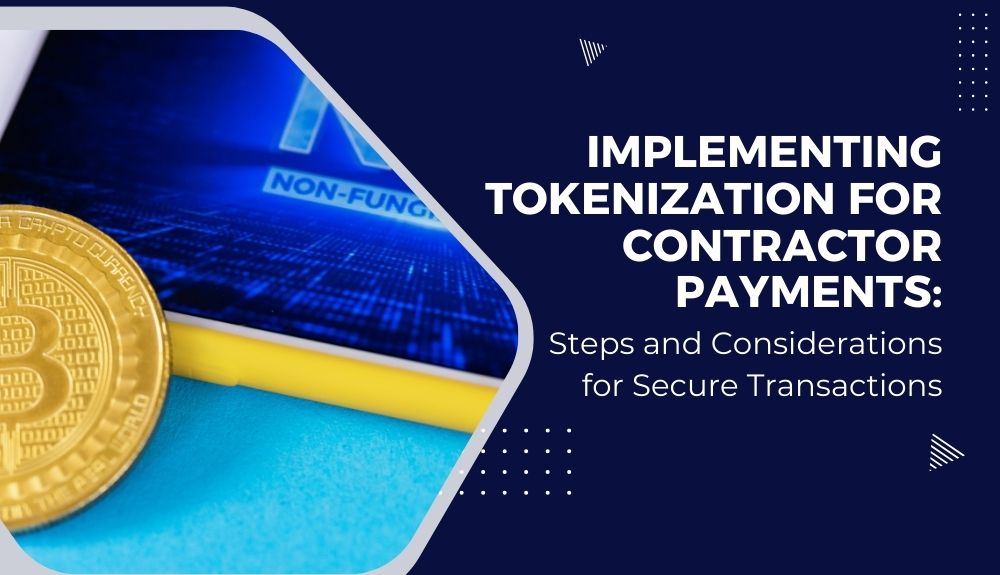Are you tired of worrying about the security of contractor payments? Say goodbye to those concerns with tokenization! In the world of digital transactions, implementing tokenization is a game-changer for ensuring secure and efficient payments to contractors. Let’s dive into how you can leverage this cutting-edge technology to streamline your payment processes while safeguarding sensitive data.
Steps for Implementing Tokenization in Payment Processes
Implementing tokenization in payment processes is a crucial step towards enhancing security and efficiency in contractor payments. To get started, the first step is to assess your current payment system and identify areas where tokenization can be integrated seamlessly. Next, choose a reputable tokenization provider that aligns with your business needs and offers robust security features.
Once you have selected a provider, collaborate closely with them to set up the tokenization process tailored to your specific requirements. This involves mapping out how tokens will be generated, stored, and used within your payment ecosystem. Additionally, ensure that all stakeholders involved in contractor payments are trained on how to interact with the new tokenized system effectively.
As you begin implementing tokenization, conduct thorough testing to validate its functionality and address any potential issues before fully integrating it into your payment workflows. Regular monitoring and maintenance of the system are vital to ensure smooth operations and ongoing compliance with industry standards.
Considerations for Choosing the Right Tokenization System
When it comes to selecting the right tokenization system for contractor payments, there are several key considerations to keep in mind. First and foremost, you’ll want to assess the compatibility of the system with your existing payment infrastructure. A seamless integration is essential for a smooth transition.
Additionally, consider the scalability of the tokenization solution. As your business grows and more contractors come on board, you’ll need a system that can easily accommodate increasing transaction volumes without compromising security.
Another crucial factor is compliance with industry regulations and data protection standards. Ensure that the tokenization system meets all necessary requirements to safeguard sensitive payment information effectively.
Moreover, evaluate the level of customer support provided by the tokenization service provider. Quick and efficient assistance can be invaluable in resolving any issues promptly and minimizing downtime.
Compare pricing structures among different tokenization systems to find one that offers a balance between cost-effectiveness and robust security features. Making an informed decision based on these considerations will set your contractor payment process up for success.
Security Measures to Ensure Safe Transactions with Contractors

Ensuring safe transactions with contractors is paramount in today’s digital landscape. Implementing robust security measures is key to protecting sensitive payment data and mitigating risks. One vital step is leveraging multi-factor authentication to verify the identity of both parties involved in the transaction.
Encryption plays a crucial role in safeguarding payment information during transmission and storage. By encrypting data at rest and in transit, organizations can prevent unauthorized access and maintain confidentiality. Regularly updating security protocols and software patches is essential to address emerging threats proactively.
Implementing strict access controls helps restrict permissions based on roles, limiting exposure to sensitive payment data. Conduct regular security audits and assessments to identify vulnerabilities and enhance defense mechanisms continually. Collaborate with trusted cybersecurity experts to stay ahead of evolving cyber threats that could compromise contractor payments.
Common Challenges and Solutions for Implementing Tokenization
When implementing tokenization for contractor payments, there are common challenges that organizations may face. One challenge is the initial setup cost and integration with existing systems. This can be addressed by conducting a thorough cost-benefit analysis to justify the investment.
Another challenge is ensuring compliance with industry regulations and standards. Organizations can overcome this by selecting a tokenization system that meets regulatory requirements and provides robust security features.
Additionally, maintaining data accuracy and consistency throughout the tokenization process can pose a challenge. Implementing regular audits and data validation procedures can help address this issue effectively.
User adoption and training may present challenges during implementation. Providing comprehensive training sessions and ongoing support to users can facilitate a smooth transition to the new payment process.
Conclusion: Embracing Tokenization for Secure and Efficient Contractor Payments
Embracing tokenization for secure and efficient contractor payments is a strategic move that not only enhances data security but also streamlines payment processes. By implementing tokenization, businesses can safeguard sensitive information, reduce the risk of fraud, and ensure seamless transactions with contractors.
Choosing the right tokenization system, following best security practices, and addressing common challenges will contribute to a successful integration of tokenization in payment processes. With careful consideration and proactive measures in place, businesses can enjoy the benefits of enhanced security and efficiency when dealing with contractor payments.
In today’s digital age where data breaches are increasingly common, prioritizing security in financial transactions is paramount. Tokenization offers a robust solution to protect valuable data while facilitating smooth payment experiences for both businesses and contractors. By embracing tokenization, organizations can elevate their payment processes to new levels of security and reliability.
